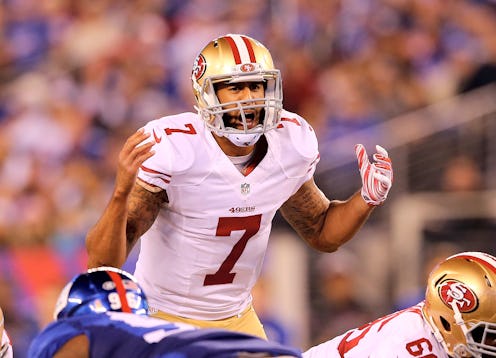News
Kaepernick's Style Of Protest Has Been Seen Before
On Friday, the intersection of sports and politics flared to life in huge, combustible fashion, with the news that San Francisco 49ers quarterback Colin Kaepernick refused to stand during the national anthem. And while that might not sound that familiar if you're not a big sports fan, if you were a fan of NBA basketball in the 1990s, you know we've been here before: Kaepernick's anthem protest mirrored that of Mahmoud Abdul-Rauf, the star Denver Nuggets guard who refused to stand for the anthem back in 1996.
Kaepernick, 28, reportedly told NFL Media after the 49ers Friday night preseason game against the Green Bay Packers that he had no intention of standing during the anthem, because he refused to salute a flag and a country "that oppresses black people and people of color." Specifically, he cited instances of "bodies in the street and people getting paid leave and getting away with murder." It was a clear reference to police shootings of people of color that have risen in the national consciousness in recent years, starting off in a big way with the killing of Michael Brown in Ferguson, Missouri in 2014.
Back in 1996, Abdul-Rauf similarly refused to stand for the anthem, although he did it for quite sometime before anybody noticed — in an interview with Jorge Sierra in 2010, he said that he'd been sitting quietly during the anthem for months before anybody even noticed.
It was something that was gradual and it was never meant to bring attention to myself. I did it for like three or four months before anybody even knew I was doing it. If I wanted to bring attention to myself, I wouldn’t have come out or I would have put myself in the middle of the floor. But I never did that because it was something that I was dealing with internally.
For what it's worth, Abdul-Rauf faced steeper consequences than Kaepernick has for their shared acts of quiet protest. So far at least, since this story and the activism behind it is bound to follow Kaepernick around for a long time. In Abdul-Rauf's case, he was suspended by the NBA without pay for the incident, and was ultimately forced to strike a deal — to stand with his teammates during the anthem while saying a silent Islamic prayer — to continue his professional career, which was never quite the same. And while the notion of a contracted employee being suspended without pay for such a thing might be startling in many ways, in this case it was backed up by an official league rule. As The New York Times reported at the time, Abdul-Rauf was bound by a one-sentence clause in the NBA rulebook, mandating that "players, coaches and trainers are to stand and line up in a dignified posture along the sidelines or the foul line during the playing of the national anthem."
Kaepernick, at least according to the NFL's official response, is not breaching any such rule — according to NFL insider Ian Rapoport, the league's official statement is that "players are encouraged but not required to stand during the playing of the national anthem." He's so far earned the public scorn of some NFL players, and the support of others. NFL columnist Mike Freeman reported on Saturday morning that he might have a harder time with the NFL's team executives, however.
For what it's worth, other players in difference sports have taken similar stands, too, although Kaepernick's and Abdul-Rauf's gained a unique level of visibility (and inspired a lot of vitriol) thanks to them sitting out the Star Spangled Banner. Notably, former Toronto Blue Jays first baseman Carlos Delgado refused to stand during in-stadium playings of "God Bless America" in 2004, an entirely separate musical ode introduced into Major League Baseball parks following the terrorist attacks of September 11th, 2001. Some of the parks still play it to this day.
